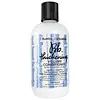What's inside
What's inside
 Key Ingredients
Key Ingredients

 Benefits
Benefits

 Concerns
Concerns

 Ingredients Side-by-side
Ingredients Side-by-side

Water
Skin ConditioningPyrus Malus Fruit Extract
Skin ConditioningCetyl Alcohol
EmollientGlycerin
HumectantPropanediol
SolventCetearyl Alcohol
EmollientCocos Nucifera Oil
MaskingHydrolyzed Rice Protein
Skin ConditioningEmblica Officinalis Fruit Extract
Skin ConditioningHelianthus Annuus Seed Oil
EmollientArginine
MaskingPanthenol
Skin ConditioningTocopherol
AntioxidantLactic Acid
BufferingLauroyl Lysine
Skin ConditioningDicaprylyl Ether
EmollientEthylhexylglycerin
Skin ConditioningBehentrimonium Methosulfate
Brassicamidopropyl Dimethylamine
Skin ConditioningHydroxypropyl Starch Phosphate
Polyester-11
Skin ConditioningHydrogenated Lecithin
EmulsifyingParfum
MaskingLimonene
PerfumingHexyl Cinnamal
PerfumingLinalool
PerfumingHydroxycitronellal
PerfumingDisodium EDTA
Potassium Sorbate
PreservativeSodium Benzoate
MaskingWater, Pyrus Malus Fruit Extract, Cetyl Alcohol, Glycerin, Propanediol, Cetearyl Alcohol, Cocos Nucifera Oil, Hydrolyzed Rice Protein, Emblica Officinalis Fruit Extract, Helianthus Annuus Seed Oil, Arginine, Panthenol, Tocopherol, Lactic Acid, Lauroyl Lysine, Dicaprylyl Ether, Ethylhexylglycerin, Behentrimonium Methosulfate, Brassicamidopropyl Dimethylamine, Hydroxypropyl Starch Phosphate, Polyester-11, Hydrogenated Lecithin, Parfum, Limonene, Hexyl Cinnamal, Linalool, Hydroxycitronellal, Disodium EDTA, Potassium Sorbate, Sodium Benzoate
Aloe Barbadensis Leaf Juice
Skin ConditioningCetearyl Alcohol
EmollientGlycerin
HumectantCoco-Caprylate
EmollientBehentrimonium Chloride
PreservativePolyquaternium-10
Polyquaternium-7
Argania Spinosa Kernel Oil
EmollientMentha Piperita Oil
MaskingPanthenol
Skin ConditioningMentha Arvensis Callus Lysate
AntioxidantHydrolyzed Quinoa
Skin ConditioningLinum Usitatissimum Seed Oil
PerfumingHelianthus Annuus Seed Oil
EmollientSqualane
EmollientSimmondsia Chinensis Seed Oil
EmollientMacadamia Ternifolia Seed Oil
EmollientUrtica Dioica Leaf Extract
Skin ConditioningEquisetum Arvense Leaf Extract
AstringentHibiscus Sabdariffa Flower Extract
Skin ConditioningHylocereus Undatus Fruit Extract
Skin ConditioningChamomilla Recutita Flower Extract
MaskingRosmarinus Officinalis Leaf Extract
AntimicrobialSerenoa Serrulata Fruit Extract
Skin ConditioningPentylene Glycol
Skin ConditioningCaprylyl Glycol
EmollientEthylhexylglycerin
Skin ConditioningCitric Acid
BufferingAloe Barbadensis Leaf Juice, Cetearyl Alcohol, Glycerin, Coco-Caprylate, Behentrimonium Chloride, Polyquaternium-10, Polyquaternium-7, Argania Spinosa Kernel Oil, Mentha Piperita Oil, Panthenol, Mentha Arvensis Callus Lysate, Hydrolyzed Quinoa, Linum Usitatissimum Seed Oil, Helianthus Annuus Seed Oil, Squalane, Simmondsia Chinensis Seed Oil, Macadamia Ternifolia Seed Oil, Urtica Dioica Leaf Extract, Equisetum Arvense Leaf Extract, Hibiscus Sabdariffa Flower Extract, Hylocereus Undatus Fruit Extract, Chamomilla Recutita Flower Extract, Rosmarinus Officinalis Leaf Extract, Serenoa Serrulata Fruit Extract, Pentylene Glycol, Caprylyl Glycol, Ethylhexylglycerin, Citric Acid
 Reviews
Reviews

Ingredients Explained
These ingredients are found in both products.
Ingredients higher up in an ingredient list are typically present in a larger amount.
Cetearyl alcohol is a mixture of two fatty alcohols: cetyl alcohol and stearyl alcohol. It is mainly used as an emulsifier. Emulsifiers help prevent the separation of oils and products. Due to its composition, it can also be used to thicken a product or help create foam.
Cetearyl alcohol is an emollient. Emollients help soothe and hydrate the skin by trapping moisture.
Studies show Cetearyl alcohol is non-toxic and non-irritating. The FDA allows products labeled "alcohol-free" to have fatty alcohols.
This ingredient is usually derived from plant oils such as palm, vegetable, or coconut oils. There is debate on whether this ingredient will cause acne.
Due to the fatty acid base, this ingredient may not be Malassezia folliculitis safe.
Learn more about Cetearyl AlcoholEthylhexylglycerin (we can't pronounce this either) is commonly used as a preservative and skin softener. It is derived from glyceryl.
You might see Ethylhexylglycerin often paired with other preservatives such as phenoxyethanol. Ethylhexylglycerin has been found to increase the effectiveness of these other preservatives.
Glycerin is already naturally found in your skin. It helps moisturize and protect your skin.
A study from 2016 found glycerin to be more effective as a humectant than AHAs and hyaluronic acid.
As a humectant, it helps the skin stay hydrated by pulling moisture to your skin. The low molecular weight of glycerin allows it to pull moisture into the deeper layers of your skin.
Hydrated skin improves your skin barrier; Your skin barrier helps protect against irritants and bacteria.
Glycerin has also been found to have antimicrobial and antiviral properties. Due to these properties, glycerin is often used in wound and burn treatments.
In cosmetics, glycerin is usually derived from plants such as soybean or palm. However, it can also be sourced from animals, such as tallow or animal fat.
This ingredient is organic, colorless, odorless, and non-toxic.
Glycerin is the name for this ingredient in American English. British English uses Glycerol/Glycerine.
Learn more about GlycerinHelianthus Annuus Seed Oil is the oil derived from the seeds of a Sunflower. Sunflower seed oil is non-fragrant. It is an emollient, meaning it helps to soften the skin.
Sunflower seed oil contains many fatty acids. The fatty acids found in sunflower seeds include (from highest amount to least): linoleic acid, myristic acid, palmitic acid, stearic acid, arachidic acid, oleic acid, and linolenic acid.
These fatty acids help the skin create ceramides. Ceramides play a role in repairing the skin barrier.
Helianthus Annuus Seed Oil helps moisturize the skin. This in turn helps the skin look more rejuvenated and smoother.
Sunflowers are rich in vitamin E.
Historians believe Indigenous cultures of North America domesticated sunflowers before corn. Thus they relied on sunflower oil for a variety of uses. One such use is moisturizing skin and hair.
Sunflower seed oil may not be fungal acne safe. We recommend speaking with a professional if you have any concerns.
Learn more about Helianthus Annuus Seed OilPanthenol is a common ingredient that helps hydrate and soothe the skin. It is found naturally in our skin and hair.
There are two forms of panthenol: D and L.
D-panthenol is also known as dexpanthenol. Most cosmetics use dexpanthenol or a mixture of D and L-panthenol.
Panthenol is famous due to its ability to go deeper into the skin's layers. Using this ingredient has numerous pros (and no cons):
Like hyaluronic acid, panthenol is a humectant. Humectants are able to bind and hold large amounts of water to keep skin hydrated.
This ingredient works well for wound healing. It works by increasing tissue in the wound and helps close open wounds.
Once oxidized, panthenol converts to pantothenic acid. Panthothenic acid is found in all living cells.
This ingredient is also referred to as pro-vitamin B5.
Learn more about Panthenol